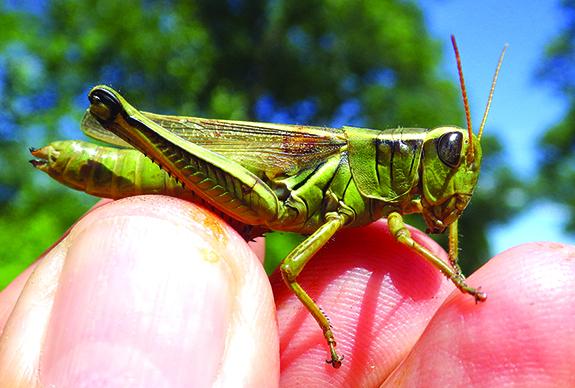It is understanding the timing of changing conditions that can make all the difference to successful fly fishing, especially in mid-summer. These thoughts were running through my mind this week while hiking a secondary road in Central Wisconsin. I felt the hotness of the mid-day sun on my back and heat radiating up from the sun bathed pavement. A gentle breeze tempered the oven-like experience making the hike a joyful experience. Grasshoppers caught my attention as they jumped into the air and fluttered with clattering wings down the road shoulder. Mid-summer road ditches always seem to be like this and are my reminder that its grasshopper time on trout streams.
Capturing one of the hoppers took several attempts, and holding it up against the blue sky, displayed how sturdy and robust this creature is. It’s spitting “tobacco juice” and biting of fingertips was tolerated while getting a good look for a later match with an appropriate fly pattern. This hopper, commonly known as the two-striped grasshopper, is frequently found along trout streams. They become active as the sun warms grassy meadows and where it shines through openings in forested canopies under which our streams flow.
This is where the timing and magnitude of change becomes important. Hoppers are activated in the warmth of the sun and peak in activity as the sun crosses the afternoon sky. Trout, especially brook trout, are also temperature reactive, but in an opposite direction. Brookies prefer streams cooled by spring water and those that flow through shadowed glades which shield the sun from heating the riffles.
Cool summer nights, like we have had this week, help extend the time period that the coolness of stream waters remain ideal for trout. As mid-day approaches both the stream and the grassy meadow warm in the sun.
Hoppers like the rapid rise in temperature whereas trout can tolerate only a moderate increase within the stream. It is a balancing of need versus tolerance in a short window of time that trout chase hoppers that through error fall into streams.
A seasoned trout fisher is familiar with this dynamic and plans morning fishing following cool nights when its hopper season. Arriving at the stream before the sun is at its zenith and with the patience of experience, waits for the meadow to absorb the sun’s energic rays. There is time to probe the stream with a thermometer to assure the safety of the brook trout. Shortly the sounds of insects awakening in the grasses and birds fluttering in their search for a late breakfast announce the approach of hopper-time.
The stream slowly warms at a pace much slower than the surrounding meadow and remains hospitable for feeding trout. Careful footsteps on the stream bank while moving upstream flush energized hoppers into flight. Their wings flutter and with a poorly controlled flight path collide with the stream.
It is the understanding of the timing that makes the day. It is hopper-time for the while when meadow temperatures rapidly rise activating hopper feeding and flight and it is brookie feeding-time while streams hold their coolness before slowly warming into the afternoon. These events coalesce into memorable fisher experiences of variable duration. Perhaps it is several hours, maybe only half that time; however, a fly mimicking a road-side hopper plotted on the stream along the grassy edge may yield the fruit of patient waiting.


